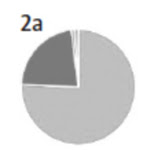Babel #4: Multi-Language Countries
The largest Austronesian language is Malay (#9, 275 million speakers), spoken in Malaysia, Indonesia, Thailand and Singapore. Gaston Dorren’s Babel on Malay focuses on Indonesia because it is a segue into an interesting question. In countries with multiple pre-existing languages, which one dominates? Is there a pattern? (In case you were wondering, Indonesia, spread over a thousand islands, has over 700 languages. Yet, the adoption of Malay as the official language has never created problems.)
Group 1 are countries with one clear dominant language e.g. Saudi Arabia, the Koreas, Bangladesh. These are no-brainers in the choice of language. At the other end of the spectrum is Group 4 – a lot of languages, with one as the largest spoken one but nowhere near an absolute majority e.g. Philippines and many African countries. Here, any one language is unlikely to dominate since the others can unify in protest. They usually pick a former colonial language as the VIL (Very Important Language) for official and higher education purposes.
Next up is Group
2a: clear majority, large minority. The risk of tensions is usually quite
high in this situation e.g. Sri Lanka (Sinhalese and Tamil), Iraq (Arabic and
Kurdish), Turkey (Turkish and Kurdish).
Take Group 2b:
clear majority, several minorities. Though it might look similar to 2a,
countries in 2b have less of linguistic friction e.g. China (Mandarin, Uighur,
Tibetans), Spain (Spanish, Catalan, Galicians). Regional linguistic rights are
granted more easily in these cases and help keep the peace.
Group 3a has two large language groups within the
same country. Here, multiple languages get official status, and both sets learn
to communicate with each other and there is little linguistic friction e.g.
Afghanistan (Dari and Pashto), Singapore (Mandarin and English), Paraguay
(Spanish and Guarani). The only exception with a lot of friction lies in Europe
– Belgium!
Last up is Group 3b: one large group, lots of minorities. Indonesia and Malaysia fall here (Malay majority); so too does Iran (Farsi majority). As does India. Linguistic friction is not high, and even if it exists, it usually doesn’t threaten to spill into violence.





Comments
Post a Comment